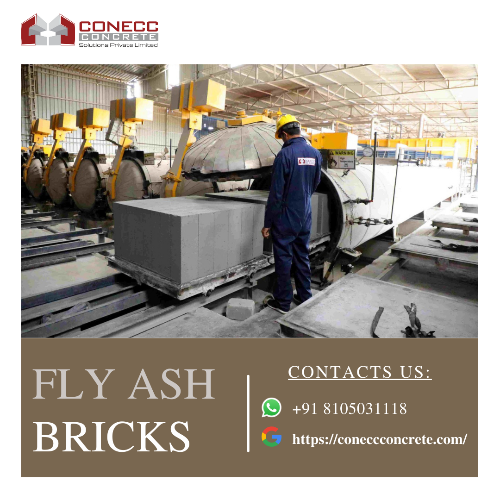What Are Fly Ash Bricks? Manufacturing Process?
 What Are Fly Ash Bricks? Manufacturing Process?
FLY ASH BRICKS
The building material fly ash brick (FAB) is made out of class C or class F fly ash and water. It's employed in the construction of masonry units. The bricks can withstand more than 100 freeze-thaw cycles after being compressed at 28 MPa (272 atm) and cured for 24 hours in a 66 °C steam bath before being toughened using an air-entrainment agent. Because of the high concentration of calcium oxide in class C fly ash, the brick is considered "self-cementing.". The process saves energy, minimizes mercury pollution in the environment, and is often 20% less expensive than traditional clay brick production. PROCESS OF MANUFACTURING OF FLY ASH BRICK Fly Ash Bricks are bricks made from the waste material left over from various manufacturers as a by-product. The powdered ash is the only solid component of the brick, while water is the primary liquid component. Other substances that have been economically protected so far are only in small amounts. The manufacture of fly ash bricks is based on the reaction of lime with fly ash silica to produce calcium silicate hydrates (C-S-H), which binds the materials together to form brick and acts as a binding material. The quality of the fly ash used determines the quality of the bricks produced 23 STEPS OF MANUFACTURING OF FLY ASH BRICKS:
01. The manufacture of bricks necessitates the mixing of fly ash, sand/stone dust, lime, and gypsum in the proper proportions. 02. Lime and gypsum are initially combined in a hydraulic mixer machine, where they are finely mixed as a dry combination. 03. The machine's grinding is halted until the mixture is thoroughly and uniformly mixed. 04. Following the aforesaid procedure, the needed amount of fly ash and sandstone is taken. 05. The ash and sand/stone dust are then mixed together in the pan to make a homogenous mixture. 06. When cement is used in place of lime, the pan mixture is first mixed with fly ash and sand/stone dust, and then cement is added to achieve a homogeneous dry mixture. 07. The mixer machine is now turned on, and the aforesaid combination is uniformly ground in a dry state. 08. Once a consistent dry mixture of fly ash, sand/stone dust, and cement has been obtained, water is added to the pan-mixed. 09. The required amount of water must be added to the mixture, as the mixture must be concentrated enough to be molded into the brick. 10. It should be emphasized that the amount of water used must not be excessive, and the water content ratio per kilogram of cement must not exceed 0.6 percent. 11. When the number of materials is little, it is necessary to convey them using labor. 12. When the quantity of the mixture is greater, a conveyor belt could be used to transfer the mixture to the mould. 13. Three sets of brick moulds make up the hydraulic machine. 14. Moulds might vary depending on the machines that are available. 15. Following the transfer of the mixture content to the position of the brick mould, it must be filled into the holes provided in the machine that mimics the brick mould. 16. The mould is typically found on a circular table that may rotate in a clockwise orientation. 17. After the ingredients have been poured into the mould, the table is permitted to rotate in a clockwise direction before remaining under the machine's closed half. 18. The mixture is hydraulically squeezed to produce bricks at that point, and the pressed bricks are then mechanically pushed outside the brickmould. 19. The bricks are transferred to the Planck once they have been removed from the mould. 20. The moving of the bricks must be done with caution, since the pressure given to them may cause them to break. 21. For the sake of reference, certain brick ratios must be finished and noted above the brick. 22. When the Planck is filled with bricks, the Planck lifter transports them to the air-drying process, where the bricks are air-dried for 2 to 3 days. 23. Water curing is carried out for a specified number of days in order to attain the appropriate strength. CONCLUSIONS
This research looked into the properties of burnt clay bricks with fly ash. The use of fly ash in the production of brick examples could be a cost-effective solution to dispose of this waste. This could lead to the conservation of natural resources such as fertile soil and the enhancement of the qualities of burnt clay bricks. Lighter bricks can be produced by incorporating fly ash in clay bricks. An 18% reduction in weight could be achieved after a 25% replacement of clay with fly ash. This reduction in the weight https://coneccconcrete.com/blog/flyash-blocks |
|
NECC Concrete Solutions is the leading manufacturer of Autoclaved Aerated Concrete (AAC) blocks in Haryana. AAC blocks are also known as Fly ash / Lightweight Brick/Block. NECC prides itself on maintaining the highest level of customer service and support.
NECC Concrete Solutions https://neccaac.com/ |
«
Return to Globafeat
|
1 view|%1 views
| Free forum by Nabble | Edit this page |

